
2019 Kingston lineup
For a start, a little dry theory. All Kingston SSDs can be divided into four large groups. This division is conditional, since the same drives fall into several families at once.
- SSDs for system builders: 2.5 "SATA SSDs, M.2 and mSATA Kingston UV500 and two NVMe drive models - Kingston A1000 and Kingston KC2000;
- SSD for users . The same models as in the previous group and, in addition, SATA SSD Kingston A400;
- SSD for companies : UV500 and KC2000;
- Corporate SSD . Drives DC500 series, which became the hero of this review. The DC500 line is divided into DC500R (primary reading, 0.5 DWPD) and DC500M (mixed loads, 1.3 DWPD).
In the test, the Truesystems had Kingston DC500R with a capacity of 960 GB and Kingston DC500M with 1920 GB of memory. Let's refresh their characteristics:
Kingston DC500R
- Volume: 480, 960, 1920, 3840 GB
- Form Factor: 2.5 ", height 7 mm
- Interface: SATA 3.0, 6 Gb / s
- Declared performance (for model 960 GB)
- Serial access: read - 555 MB / s, write - 525 MB / s
- Random access (4 KB block): read - 98,000 IOPS, write - 20,000 IOPS
- Delay QoS (4 KB block, QD = 1, percentile 99.9%): read - 500 μs, write - 2 ms
- Emulated sector size: 512 bytes (logical / physical)
- Resource: 0.5 DWPD
- Warranty period: 5 years
Kingston DC500M
- Volume: 480, 960, 1920, 3840 GB
- Form Factor: 2.5 ", height 7 mm
- Interface: SATA 3.0, 6 Gb / s
- Declared performance (for 1920 GB model)
- Serial access: read - 555 MB / s, write - 520 MB / s
- Random access (4 KB block): read - 98,000 IOPS, write - 75,000 IOPS
- Delay QoS (4 KB block, QD = 1, percentile 99.9%): read - 500 μs, write - 2 ms
- Emulated sector size: 512 bytes (logical / physical)
- Resource: 1.3 DWPD
- Warranty period: 5 years
Truesystems experts noticed that in Kingston drives QoS values of total delay are indicated as the maximum percentile value of 99.9% (99.9% of all values will be less than the specified value). This is a very important indicator especially for server drives, since they require predictability, stability and the absence of unexpected freezes in their work. If you know what QoS delays are specified in the drive specification, then you can predict its operation, which is very convenient.
Test Parameters
Both drives were tested in a test bench simulating a server. Its characteristics:
- Intel Xeon Processor E5-2620 V4 (8 cores, 2.1 GHz, HT on)
- 32 GB of memory
- Supermicro X10SRi-F motherboard (1x socket R3, Intel C612)
- CentOS Linux 7.6.1810
- To generate the load, FIO version 3.14 was used
And again about which SSDs were tested:
- Kingston DC500R 960GB (SEDC500R960G)
- Firmware: SCEKJ2.3
- Volume: 960 197 124 096 bytes
- Kingston DC500M 1920 GB (SEDC500M1920G)
- Firmware: SCEKJ2.3
- Volume: 1 920 383 410 176 bytes
Testing methodology
The basis was the popular SNIA Solid State Storage Performance Test Specification v2.0.1 test suite , but testers made adjustments to it to make workloads closer to the actual use of corporate SSDs in 2019. In the description of each test, we note what exactly was changed and why.
I / O Operations Test (IOPS)
This test measures the number of I / O operations per second for blocks of various sizes (1024 KB, 128 KB, 64 KB, 32 KB, 16 KB, 8 KB, 4 KB, 0.5 KB) and random access with different read / write ratios record (100/0, 95/5, 65/35, 50/50, 35/65, 5/95, 0/100). Truesystems experts used the following test parameters: 16 threads with queue depth of 8. At the same time, a 0.5 KB block (512 bytes) did not run at all, since its size was too small to seriously load drives.
Kingston DC500R in IOPS Test

Tabular data:

Kingston DC500M in IOPS Test
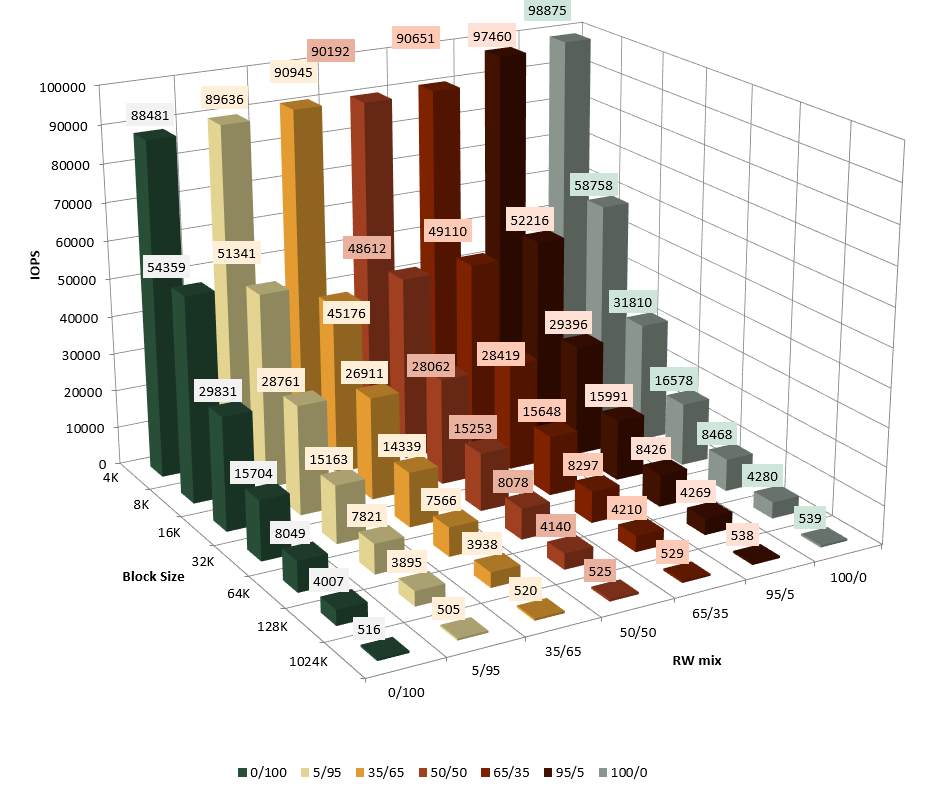
Tabular data:
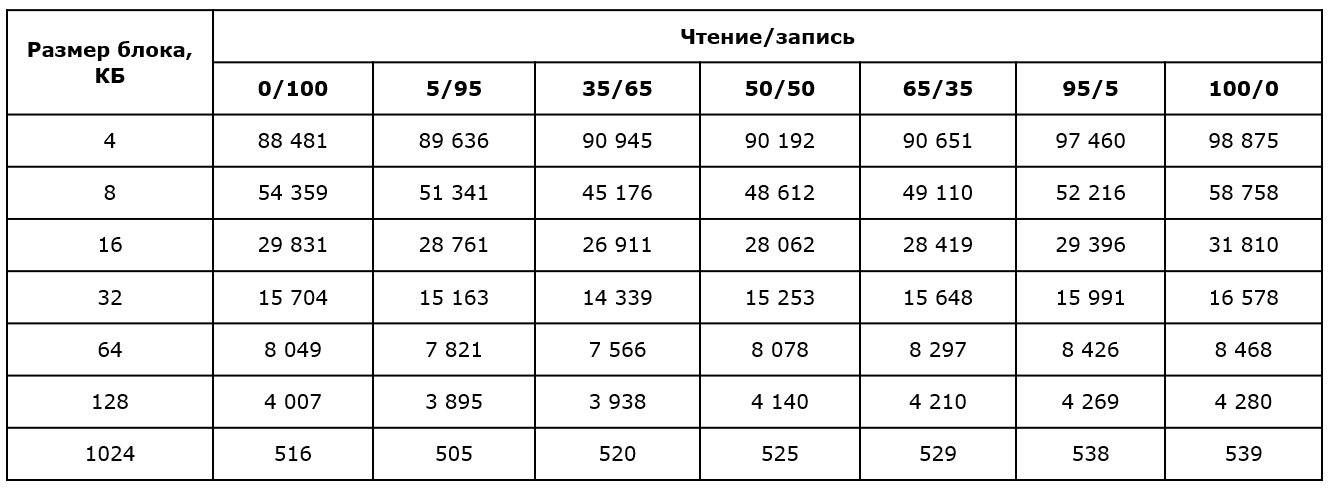
The IOPS test does not imply entering saturation mode, so it goes quite easily. Both drives coped perfectly, fully meeting the declared factory characteristics. Subjects showed excellent performance in writing blocks of 4 KB: 70 and 88 thousand IOPS. This is great, especially for the reading-oriented Kingston DC500R. As for the read operations themselves, these SSDs not only surpass their factory values, but also come close to the ceiling performance of the SATA interface.
Bandwidth test
This test examines sequential access throughput. That is, both SSDs perform sequential read and write operations with 1 MB and 128 KB blocks. 8 threads with queue depth of 16 per thread.
Kingston DC500R:
- 128 KB sequential read: 539.81 MB / s
- 128 KB sequential write: 416.16 MB / s
- 1 MB sequential read: 539.98 MB / s
- 1 MB sequential write: 425.18 MB / s
Kingston DC500M:
- 128 KB sequential read: 539.27 MB / s
- 128 KB sequential write: 518.97 MB / s
- 1 MB sequential read: 539.44 MB / s
- 1 MB sequential write: 518.48 MB / s
And here we also see that the sequential read speed of the SSD has approached the bandwidth limit of the SATA 3 interface. In general, no problems with sequential reading are found in Kingston drives.
Sequential recording is slightly behind, which is especially evident in Kingston DC500R, which belongs to the read intensive class, that is, it is designed for intensive reading. Therefore, Kingston DC500R in this part of the test gave values even lower than those stated. But Truesystems experts believe that for a drive that is not designed for such loads (recall that the resource of the DC500R is 0.5 DWPD), these 400-odd MB / s can still be considered a good result.
Delay test
As we already noted, this is the most important test for corporate drives. After all, it can be used to determine what problems arise during the long daily operation of an SSD-drive. The standard SNIA PTS test measures the average and maximum latency for various block sizes (8 KB, 4 KB, 0.5 KB) and read / write ratios (100/0, 65/35, 0/100) with minimal queue depth (1 stream with QD = 1). However, the editors of Truesystems decided to seriously modify it in order to obtain more realistic values:
- Excluded the 0.5 KB block;
- Instead of a single-threaded load with queues 1 and 32, the load varies in the number of flows (1, 2, 4) and the depth of the queue (1, 2, 4, 8, 16, 32);
- Instead of the 65/35 ratio, 70/30 is used as a more realistic one;
- Not only average and maximum values are given, but also percentiles 99%, 99.9%;
- for the selected value of the number of streams, graphs of the dependence of the delay (99%, 99.9%, and average value) on IOPS are plotted for all blocks and read / write ratios.
The data were averaged over four of 25 rounds lasting 35 seconds (5 “warm-ups” + 30-second load) each. For graphs, Truesystems editors chose a series of values with queue depths of 1 to 32 at 1–4 threads. This was done in order to evaluate the performance of drives taking into account the delay, that is, the most realistic indicator.
Indicators of average delay:
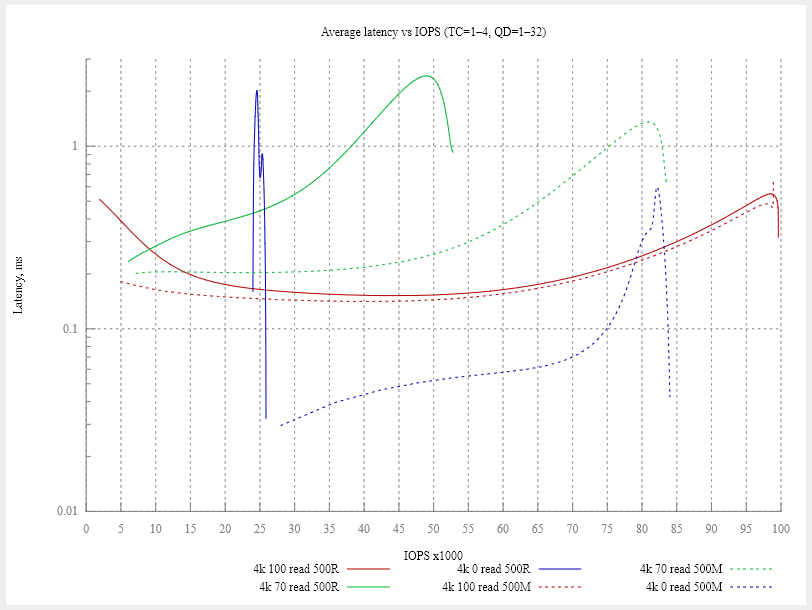
This graph illustrates the difference between the DC500R and DC500M. Kingston DC500R is designed for intensive read operations, so the number of write operations does not grow with increasing load, remaining at 25,000.
If you look at the mixed load (70% of writing and 30% of reading), the difference between the DC500R and DC500M also remains noticeable. If we take the load corresponding to a delay of 400 microseconds, we see that the universal DC500M has a performance three times higher. This is also quite natural and stems from the characteristics of drives.
A curious detail - the DC500M is ahead of the DC500R even at 100% reading, providing less latency with the same amount of IOPS. The difference is small, but very interesting.
99% percentile delay:

99.9% percentile delay:

According to these graphs, Truesystems experts checked the reliability of the declared characteristics for QoS delay. The specifications indicated an indicator of 0.5 ms for reading and 2 ms for writing for a 4 KB block with queue depth equal to 1. We are proud to announce that these numbers were confirmed, also with a large margin. Interestingly, the minimum read delay (280–290 μs for DC500R and 250–260 μs for DC500M) is achieved not at QD = 1, but at 2–4.
The write delay at QD = 1 was 50 μs (such a low delay is obtained due to the fact that at low load the drive cache is guaranteed to be freed, and we always see a delay when writing to the cache). This indicator is 40 times lower than the declared value!
Continuous Performance Test
Another extremely realistic test, which studies the change in performance (IOPS and latency) during long intensive work. As a working scenario, random recording in 4 KB blocks was selected for 600 minutes. The meaning of this test is that with such a load, the SSD drive enters saturation mode when the controller is continuously collecting garbage to prepare free blocks of memory for writing. That is, this is the most exhausting mode - exactly what enterprise-class SSDs facing in real servers are faced with.
Based on the test results, Truesystems received the following performance indicators:
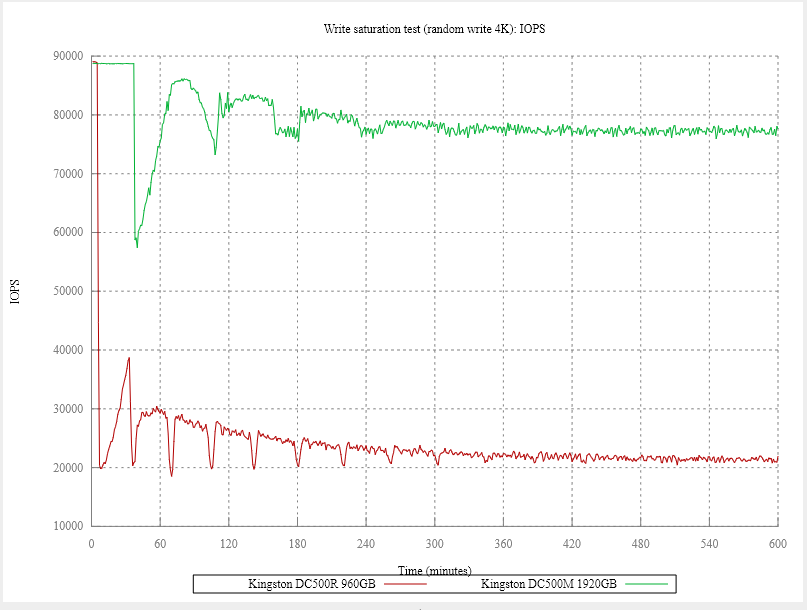
The main result of this part of the test: both Kingston DC500R and Kingston DC500M in real work exceed their own factory values. When the prepared blocks are finished, t begins the saturation mode, Kingston DC500R is kept at 22,000 IOPS (instead of 20,000 IOPS). Kingston DC500M is in the range of 77-78,000, although 75,000 IOPS are declared in the drive profile. The difference between the drives is also clearly visible in this test: if a high proportion of write operations is expected in the drive’s workflow, Kingston DC500M is more than three times more productive (we also remember that DC500M performed better in latency as well in reading operations).
Delays during continuous write operations are shown in the following graph. Median value, percentiles 99%, 99.9% and 99.99%.

We see that the latency of both drives increases in proportion to the decrease in performance, without sharp failures and inexplicable peaks. This is very good, since it is precisely the predictability that is expected from corporate drives. Truesystems experts emphasize that the testing took place in 8 threads with a queue depth of 16 for each thread, therefore, not absolute values, but dynamics are important. When they tested the DC400, there were severe delays in this test due to the controller, but on this graph the Kingston DC500R and Kingston DC500M do not have such problems.
Load delay distribution
As a bonus, Truesystems editions drove Kingston DC500R and Kingston DC500M through simplified test No. 13 of the SNIA SSS PTS 2.0.1 specification. We studied the distribution of delay under load in the form of a special CBW pattern:
Block sizes:
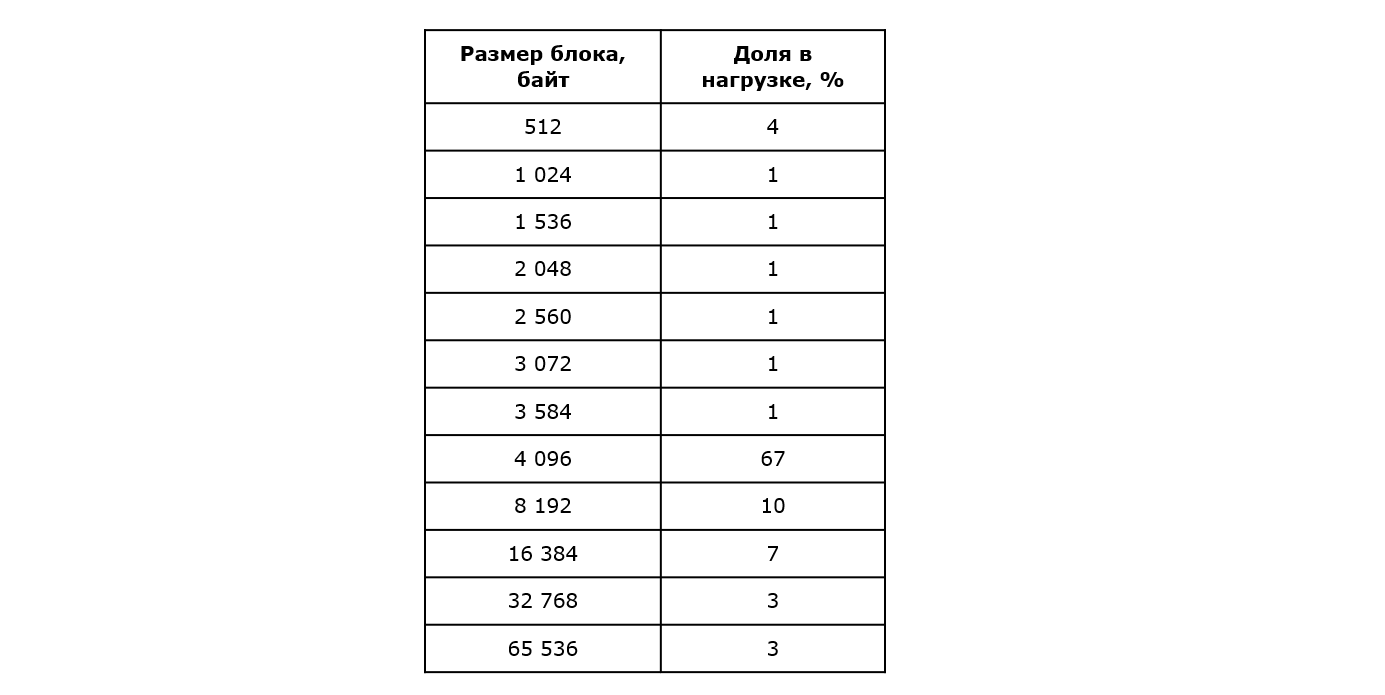
Load distribution by drive volume:

Read / write ratio: 60/40%.
After secure erase and preload, testers ran 10 60-second rounds of the main test for the number of threads 1–4 and the queue depth 1–32. Based on the results, a histogram of the distribution by values from the rounds corresponding to the average performance (IOPS) was built. For both drives, it was achieved with a single stream with queue depth of 4.
As a result, the following values were obtained:
DC500R: 17949 IOPS at 594 μs Delay
DC500M: 18880 IOPS at 448 μs.
The delay distribution was analyzed separately for reading and writing.
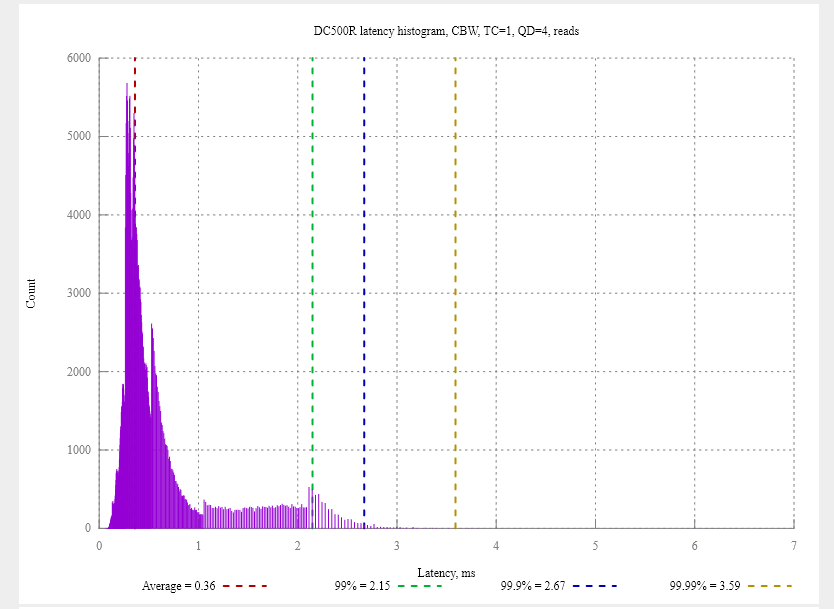



Conclusion
The Truesystems editors concluded that the Kingston DC500R and Kingston DC500M benchmarks are clearly treated as good. Kingston DC500R does very well with read operations, and can be recommended as a professional equipment for the respective tasks. For mixed loads and, if necessary, more resources, Truesystems recommends Kingston DC500M. The publication also notes attractive prices for the entire model line of Kingston corporate drives and acknowledges that the transition to TLC 3D-NAND really helped lower the price without losing quality. Truesystems experts also liked Kingston’s high level of technical support and a five-year warranty on the DC500 series of drives
PS We remind you that the original review can be read on the Truesystems website .
For more information on Kingston Technology products, visit the company's website .